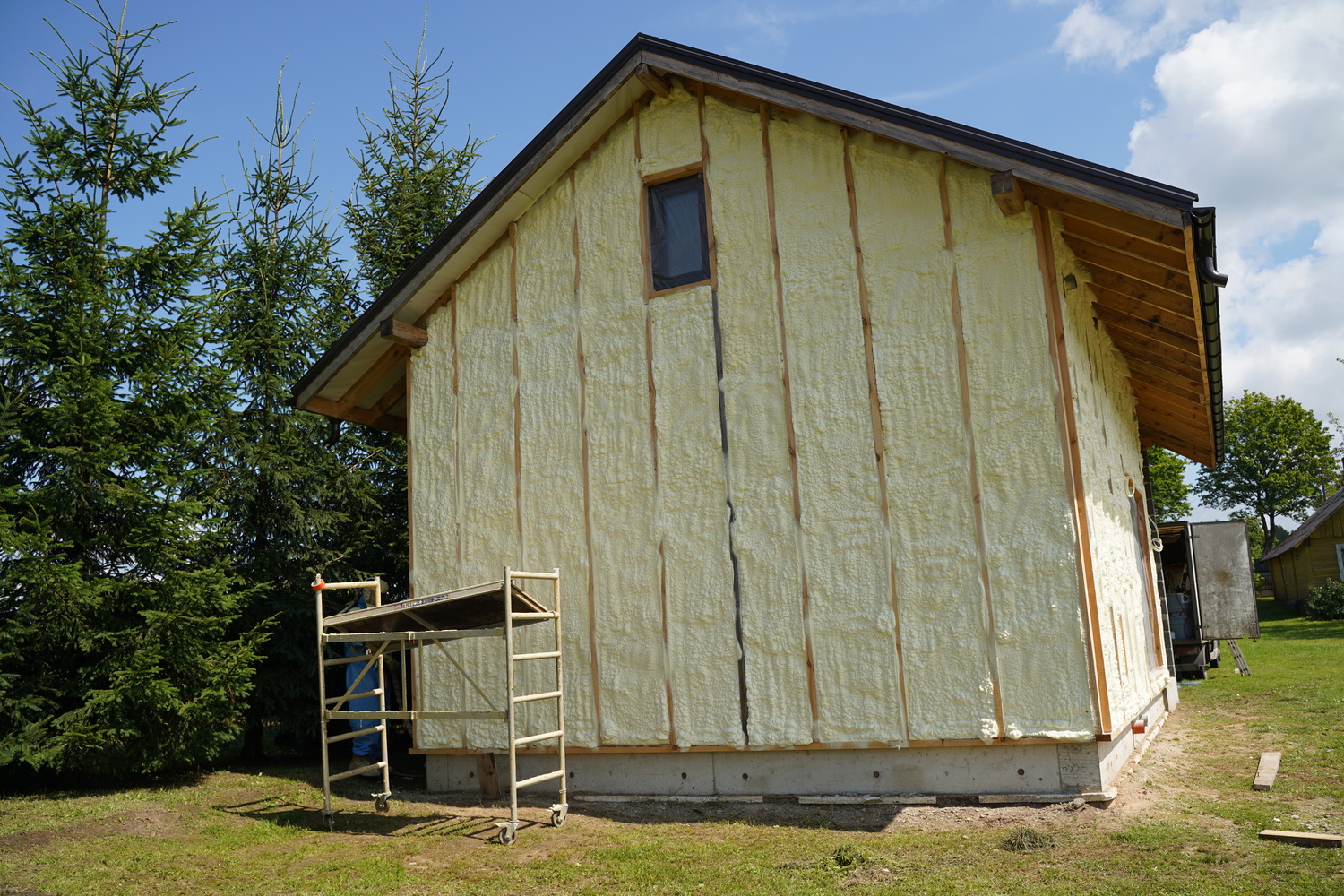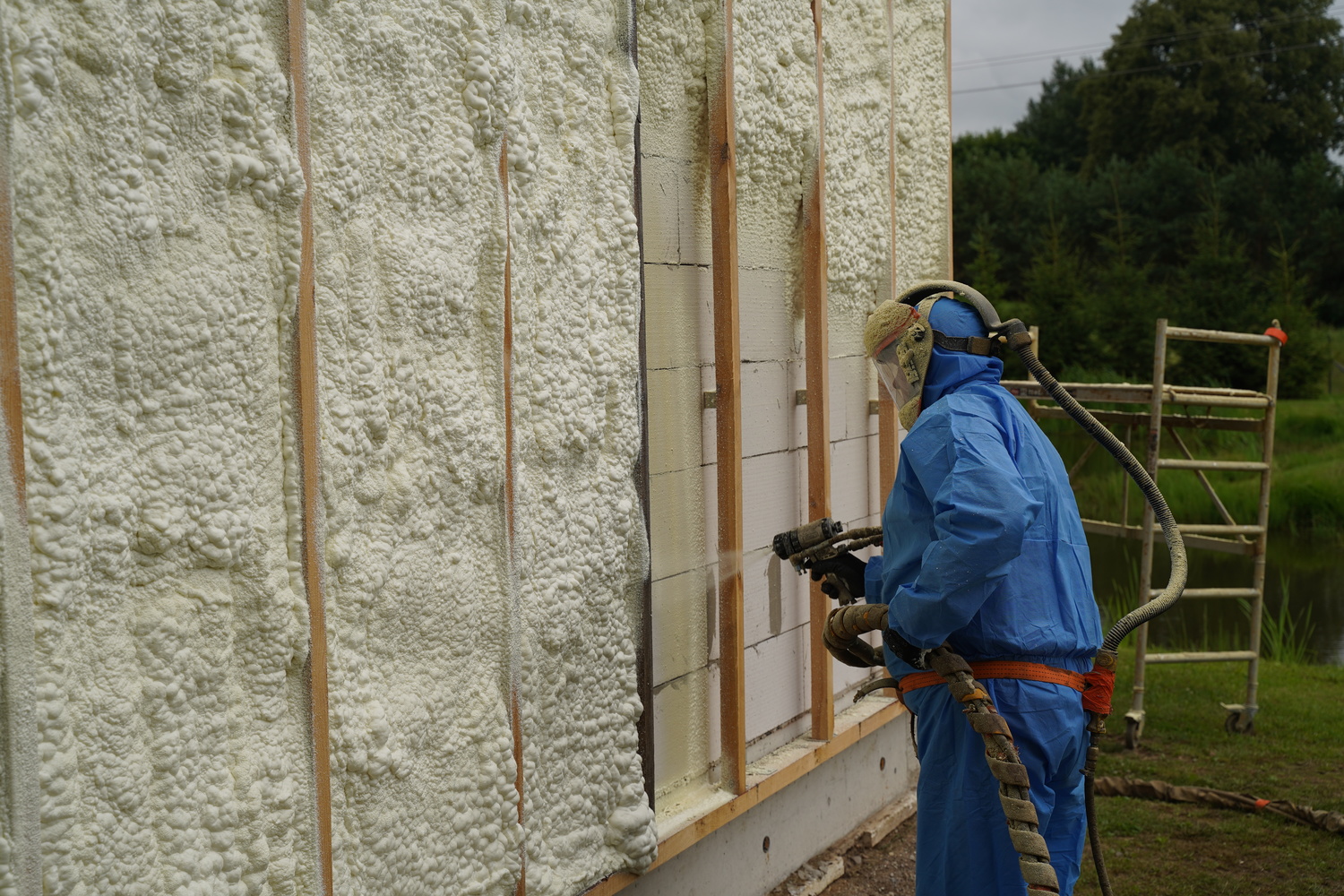There is no doubt that sprayed polyurethane foam has long been an effective method for sealing window and door frames. However, continuous roof and wall insulation with polyurethane foam is still considered unusual and raises many questions. Naturally, when a new material appears on the market, it takes time to establish itself.
Sprayed polyurethane foam has been used worldwide for the insulation of enclosures and roofs for nearly 40 years and has proven to be 100% effective.
Polyurethane Foam
Polyurethane foam is created during spraying when two materials – resin and a catalyst – mix. During spraying, a chemical reaction takes place, causing the foam to expand and release heat, with a noticeable odor. This is why installers wear protective suits. Once the material has cured, it becomes completely neutral, releasing no compounds or odors. After 24 hours, the treated room is safe to inhabit. Polyurethane foam does not contain formaldehydes or volatile organic compounds.
The polyurethane foam, made from two components, is odorless and forms a solid, continuous layer.
Polyurethane foam is made from two chemical substances, but the compound is neutral, releasing no odors or harmful materials into the environment. It is similar to table salt, where the separate sodium and chlorine components are unstable, but when combined, they form a stable, beneficial compound.
Polyurethane foam is much more common in our surroundings than we may realize, as its density can vary widely, making it suitable for various uses. In sandwich panels, which are used to build nearly all shopping centers, industrial buildings, and warehouses, the insulating material is polyurethane foam. Many household items, mattresses, and even pipes, heaters, refrigerators, and storage tanks are insulated with foam polyurethane. Thus, polyurethane has been tested in various situations, and it poses no harmful effects.
Insulation with Sprayed Foam
Applying any thermal insulation boards to a smooth, uniform surface is not particularly difficult, but such surfaces are rare. Insulating any building involves sealing joints, penetrations, and gaps, and there are often places that are hard to reach. Insulating such areas with thermal insulation boards is time-consuming, labor-intensive, and requires precision: the boards must be cut, laid in several layers, with vapor barriers and other layers joined and secured to the base.
When sprayed onto any surface, polyurethane foam quickly expands about 100 times in 5–8 seconds and penetrates all cracks, forming a continuous, uniform, and even insulating layer. The key benefit is that the foam infiltrates even the smallest gaps, leaving no air pockets, meaning the insulation is 100% airtight. Furthermore, the foam adheres tightly to almost any surface. It bonds so firmly that it can't be pulled off by hand, and only cutting is possible. In contrast, when insulating with other materials, especially on uneven, old, or worn surfaces, air pockets almost always remain, creating thermal bridges.
Insulating Properties of Polyurethane Foam
Sprayed polyurethane foam can have open or closed cells. High-density closed-cell polyurethane foam is an excellent thermal insulator, while low-density open-cell foam is known for its good sound insulation properties and is used for both thermal and sound insulation.
Open-cell polyurethane foam is ideal for insulating wooden and log houses, as it effectively fills all gaps. The insulation layer is vapor-permeable, and due to the foam’s elasticity, the layer remains stable even when the structure undergoes minor deformations. Many people worry that insulating a log house with polyurethane foam will prevent the walls from "breathing." This is a misconception. First, open-cell polyurethane foam is vapor-permeable, though its permeability is not high. Secondly, walls and roofs do not need to "breathe" in the way people often think. This so-called "breathing" refers to the escape of water vapor, which causes heat loss, and such loss should be minimized. Excess water vapor should exit through the ventilation system. To be effective, insulation must be airtight, and fresh air must be provided through a ventilation system. When both systems – insulation and ventilation – are properly combined, they function efficiently. This is why older homes often feel cold, and their walls become damp and moldy. Polyurethane foam is also unattractive to rodents and other pests, which avoid the material, do not chew it, and do not nest in it.
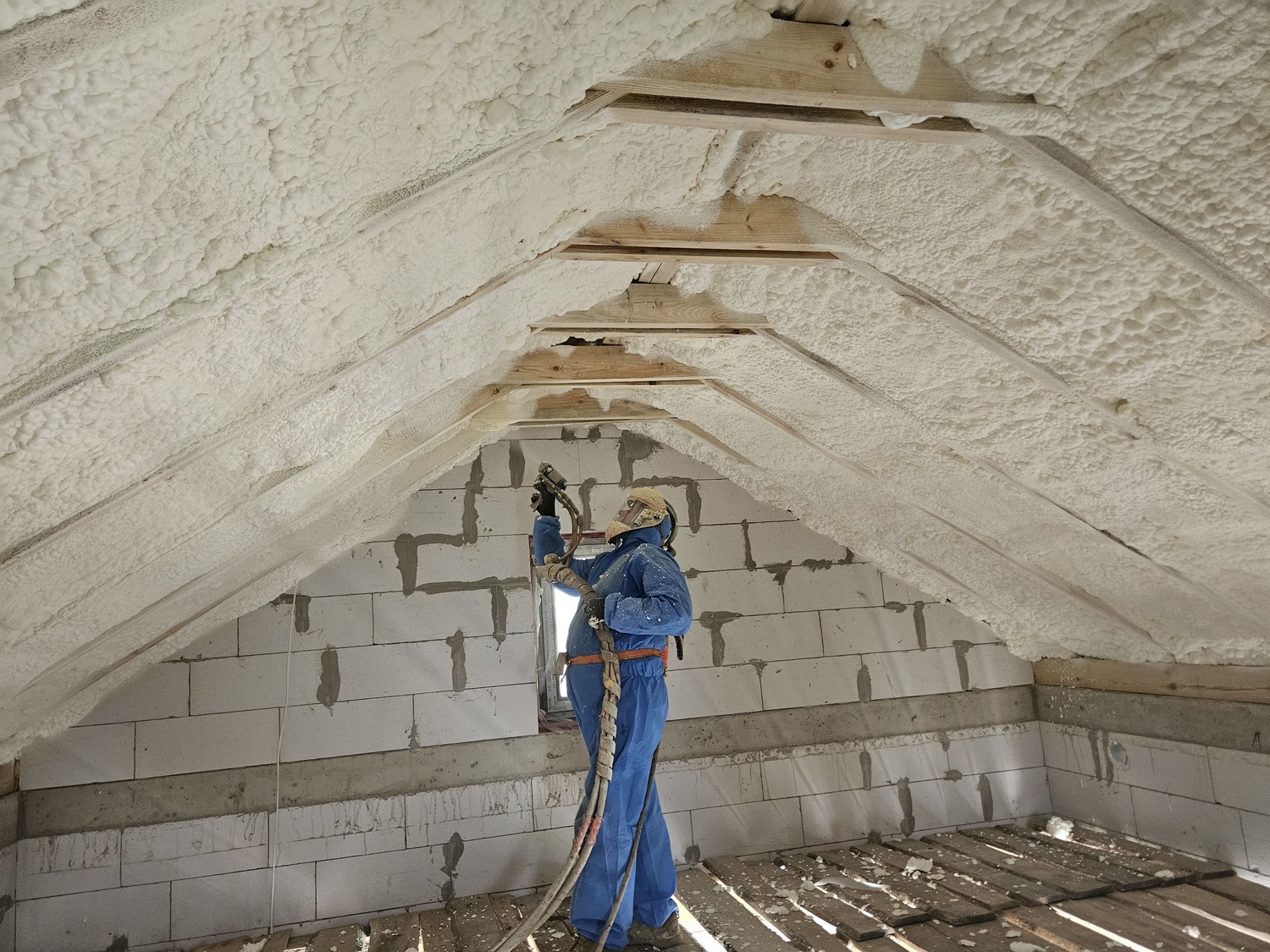
Sprayed polyurethane foam is suitable for insulating both old and new buildings, from the interior and exterior.
Why Insulate with Polyurethane Foam?
The most important characteristic of any thermal insulation material is its thermal conductivity, which is represented by the U-value (lambda). Open-cell and closed-cell polyurethane foams, as well as different layer thicknesses, have varying thermal conductivity values. Open-cell polyurethane foam has slightly poorer thermal insulation properties compared to closed-cell foam. However, even the "poorer" open-cell polyurethane foam still outperforms many other insulation materials in terms of thermal conductivity.
For the same thermal parameters, a thinner layer of closed-cell polyurethane foam is required to achieve the same level of insulation. This is particularly important when insulating interior walls.
Any thermal insulation material must not only have good thermal properties but also resist moisture to maintain its effectiveness. The water vapor resistance factor (not to be confused with water absorption) µ indicates how many times the vapor resistance of a material's layer is greater than that of an equivalent thickness of still air. That is, how much water vapor can penetrate the construction is determined by the material's water vapor diffusion resistance, often expressed by the Sd coefficient – the thickness of the air layer with equivalent vapor resistance, measured in meters. The Sd value is calculated by multiplying the material’s water vapor resistance factor (µ) by the material’s thickness (in meters): Sd (m) = µ x d(m). Therefore, the higher the water vapor resistance factor µ, the higher the resulting Sd value.
Closed-cell polyurethane foam is less permeable to water vapor and creates a waterproof barrier, eliminating the need for vapor barriers. Open-cell polyurethane foam is more permeable to water vapor, and the use of a vapor barrier depends on the specific construction situation.
Insulating with polyurethane foam eliminates the risk that the insulation material will become damp or shrink over time, leading to cracks or leaks and a loss of thermal properties. This factor is especially important for roof insulation, as the roof covering can become very hot in the summer, and it is crucial that the insulation does not shrink. High-quality, stable polyurethane foam maintains its stability throughout its entire service life.
Polyurethane foam is a very versatile insulation material – it can be used to insulate walls, roofs, and foundations made from various materials. Closed-cell polyurethane foam is particularly suitable for renovating multi-apartment building roofs, where there are many communication entries, ventilation ducts, valleys, and parapets.
Insulating Pitched Roofs with Polyurethane Foam
For pitched roofs, open-cell, low-density polyurethane foam is most commonly used. It is sprayed from the inside (although external insulation is also possible) between the rafters, over a diffusion membrane. If the roof is covered with bituminous tiles, spraying can be done directly on the wooden decking.
Working with polyurethane foam is quick – within seconds, the foam expands up to 100 times its original volume and fills all gaps. If there are skylights, the foam reliably seals the window frames, which are typically a troublesome area when using other materials, requiring a lot of work. Foam can be sprayed over the diffusion membrane, but to avoid the membrane bulging, it is sprayed at a certain distance and pressure.
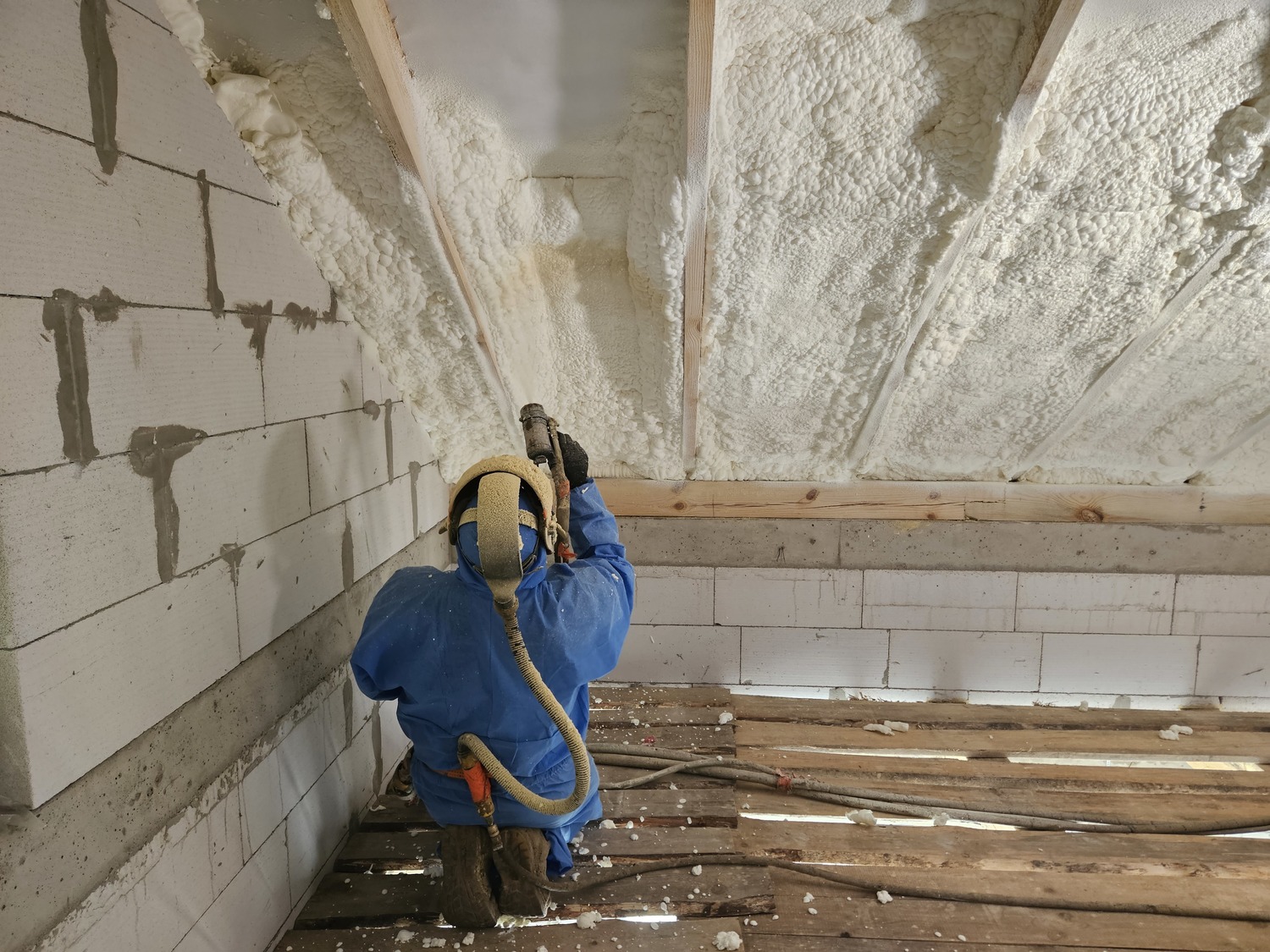
Polyurethane foam roof insulation.
If rooms are being created under a pitched roof, cross beams are fixed onto the rafters, and the finish is attached to them, as an air gap must remain between the foam layer and the finishing material.
Facade Insulation with Polyurethane Foam
Insulating with polyurethane foam is only possible in a ventilated facade construction, as the surface of the foam layer is uneven and it is not practical to smooth or plaster it. The base can be made from any type of block or brick masonry, frame construction, or logs. Before spraying, the base surface must be cleaned and dry. The thickness of the foam layer depends on the desired thermal resistance, the building's energy class, and the minimum thickness, which is most commonly applied in renovations, is 10 cm. For new buildings, it can range from 20 to 30 cm.
Before spraying the foam, a ventilated facade frame must be installed to attach finishing panels or cladding. The frame is sprayed with foam, which adheres tightly, filling all joints and gaps, and connects with the foundation insulation and roof thermal insulation. The work is quick, and the walls of a medium-sized house can be insulated in one day, without worrying about rain the following day.
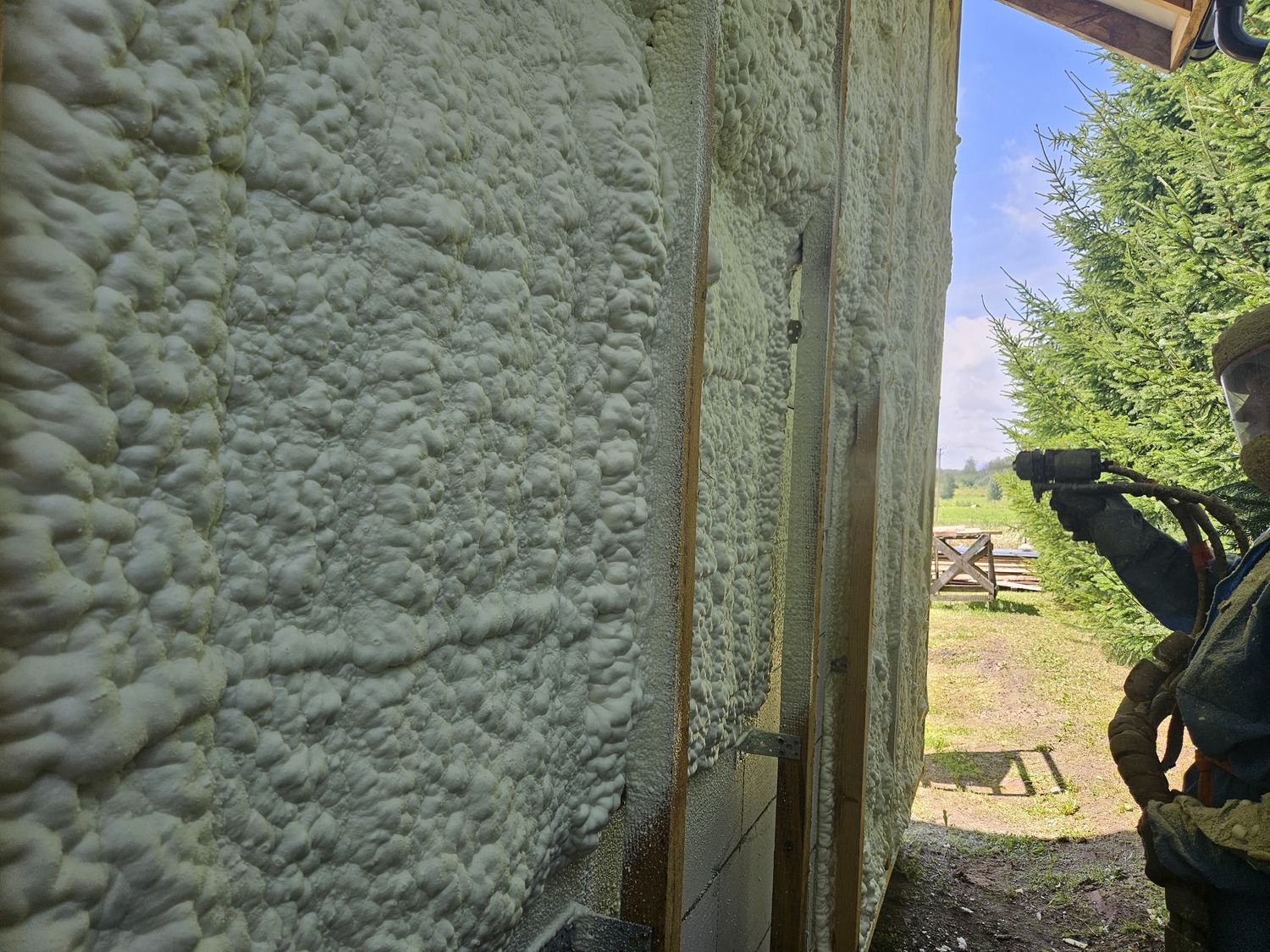
An air gap is formed between the insulation layer and the finish. A windproof membrane is applied only if the finish is ventilated.
Flat Roof Insulation with Polyurethane Foam
When insulating a flat roof with sprayed polyurethane foam, a continuous insulation layer is achieved, avoiding the need for sealing joints. A thinner covering layer provides greater thermal resistance for the roof, and the work process is simpler. The foam effortlessly fills all cracks and irregularities. There is no need to dismantle the old bitumen roofing or perform preparatory work, except for cleaning debris from the roof and removing blisters.
Even a thin surface layer (usually applied in a 4-6 cm thickness) of polyurethane foam provides the necessary roof insulation and waterproofing, which helps save on labor, materials, adhesives, and fastening elements.
As with insulation using other materials, the surface to be sprayed with polyurethane foam must be clean and dry, and it is recommended that at least two days have passed since the last rain. Old roofing blisters should also be cut and adhered to the base. If necessary, valleys, metal elements, downspouts, and ventilation chimneys should be replaced or checked. Roof slopes must be checked as well. The new layer will follow the existing slopes, and if needed, adjustments can be made. A special spraying machine is used for the foam application, and a 1-2 cm foam layer is created with each spray. For example, a 6 cm layer is formed in three applications. During a working day, 100 to 300 m² of roof area can be covered with the required thickness. Afterward, the polyurethane foam layer is covered with a UV-resistant coating—2-3 layers of a single-component vapor-permeable polyurethane membrane or a two-component polyurethane elastomer or modified polyurea.
Basement Ceiling Insulation
Residents of the lower floors of multi-story buildings are well aware that the floors in their apartments are constantly cold, with cold air coming from the basement. This issue is resolved by insulating the basement ceiling. Since polyurethane foam is sprayed, it is very easy to apply, solving several problems at once: the pipes are insulated as well, and the low ceilings drop only slightly, as a thin layer is sufficient. Basement doors often extend to the ceiling, so spraying leaves room for opening them. There is no need to cut the insulation material, and all gaps and cracks are sealed. The polyurethane foam layer on the basement ceiling is usually covered with a special fire-resistant sprayed plaster that covers the thermal insulation layer.
Designers often worry about the flammability of polyurethane foam. While polyurethane foam is flammable, it is not used in exposed structures, and the fire classification depends on all the materials used in the construction. Polyurethane foam insulation, when covered with a material that meets the EI-30 fire resistance requirements, complies with the Bs1d0 fire safety classification.

